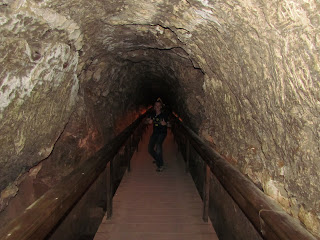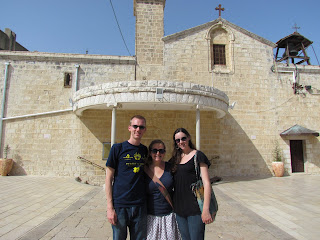Complimentary with our stay at the hostel was a tour of the old city of Nazareth, led by a zany tour guide named Linda. The tour itself was as informative as Linda's personality was completely off-the-wall (in the most hilarious way possible). Here are a number of the Nazareth attractions to which Linda took us on Saturday morning.
1. The White Mosque, a relatively modern mosque in Nazareth, currently constructing a school for Muslim, Jewish, and Christian children. I had never been in a mosque before--note that the room is oriented so that worshipers face Mecca. The pattern on the carpet is meant to apportion uniform floor-space to individuals during prayer.
2. An authentic Arabic coffee shop. We returned to the same shop later in the day and enjoyed some very strong--but very delicious--coffee.
3. A carpenter's shop--not unlike that of St. Joseph. (The woman raising her hand is Linda.)
4. An Arab spice and dried-fruit shop. The store actually sold a number of random items (soaps, beads, etc.). After the tour, we returned to this store for a delicious (and filling) five shekel "taste test." As you can see from the second picture, I'm not a fan of sunscreen.
5. The residence of the local Greek Orthodox bishop, which includes a beautiful chapel (second picture below) and ancient cave, which was the hide-out of a Christian family during an early-first-millennium persecution.
6. An ancient mansion, dated variously from the Crusader period to as early as the Roman era.
After our tour with Linda ended, the three of us detoured to Tel Megiddo. Recall that a "tel" is an artificial mound created by cities which have been ruined and re-constructed on top of one another. The mound, or Mount Megiddo, is called in Hebrew "Har Megiddo," the origin of the (Greek-to-English) word "Armageddon." Early civilizations are attested at Megiddo as early as the Neolithic period (6000 BCE), but the city rose to prominence in the Canaanite period. During this era, Megiddo was the site of a number of bloody battles against both the Egyptians and the Israelites. Eventually, Megiddo came under Israelite control, but the city was captured by the Assyrians in the 700s. In the Bible, Megiddo was the site at which King Josiah was killed; it was also the setting for one of the visions of the prophet Zechariah. In the New Testament, St. John imagines the apocalyptic battle between good and evil to take place at Megiddo, perhaps due to the fact that the city's history was so uniquely war-torn.
Despite the important history of the site, Shiri, Dana, and I found ourselves making up stories about the apocalypse, rather than actually learning about archaeology. The picture below was taken near the ancient stables--I am posing as one of the Horsemen of the Apocalypse. Megiddo DOES boast an impressive underground water system (second picture below).
After Megiddo, we returned to Nazareth to check out the holy sites which had been closed the night before. We began at the Greek Orthodox Church of the Annunciation (first picture below). A baptism was taking place in the ornate interior of the church, which was also being dressed for Palm Sunday. A short tunnel leads from the main hall of the church to a well, which--over and against the so-called Mary's Well outside--claims to be the spot at which Gabriel appeared to Mary.
Down the street, a single gated complex contains two important churches. The first, the Church of St. Joseph, is built over the remains of Joseph's carpentry workshop (some of the original stone work can be seen in the church's crypt). The crypt also preserved the mosaic floors of an earlier, 12th-century church. In the third picture, I am pretending to hammer (you know... like a carpenter?).
Across a courtyard is the Basilica of the Annunciation, the monumental Franciscan church built upon the site where--this time according to the Catholics--the Annunciation took place. The entrance to the basilica (second picture below) is simply too massive to fit in a single shot. The interior of the church (third picture below) is lavishly decorated--along the side walls are several floor-to-ceiling murals of Mary, created by artists from various countries. The mural from the United States is the fourth picture below.
The Basilica is actually two stories--in front of the main altar (first picture below) is a giant hole from which visitors can peer into the crypt (second picture below). The crypt is built around the grotto in which Mary was supposedly visited by Gabriel (third picture below).
Like the other churches, the Basilica is built upon the remains of older shrines (first picture below)--first Byzantine, then Crusader. The site is believed to have originally been the house of Mary. I've posted a number of other pictures from the Basilica, including the interior of the dome (second picture below), an impressive stained glass window (third picture below), and the magnificent church doors (fourth picture below).
































No comments:
Post a Comment